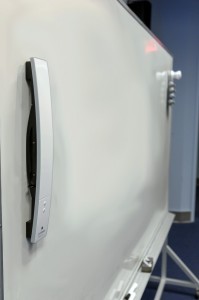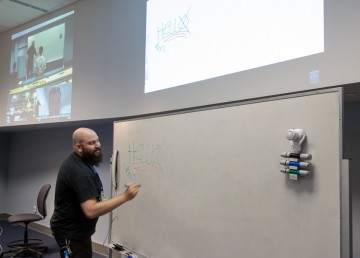Problem-based learning (PBL) is a core feature of a medical student’s education, allowing them to learn about a subject through the experience of problem solving in a collaborative environment. They work from memory to solve a case – brainstorming, collecting, and assembling information on a whiteboard.

The technology used to digitize a whiteboard.
The Residency Group for Internal Medicine based out of Royal Columbian Hospital found that they were moving the videoconference camera during their morning report sessions so that the information on the whiteboard would be visible to all attendees. This was inconvenient for the site hosting the sessions, but worse for those at Royal Inland Hospital and Kelowna General Hospital who frequently found themselves with a video feed of an unused whiteboard long after the speaker had moved on.
They pursued a number of technology solutions in an attempt to replicate the same experience, but none ever worked quite as well as a whiteboard had. The Residency Group eventually engaged MedIT to find a way to make the sessions run more smoothly, while also making the experience be more equitable across sites.
After an evaluation of available solutions and technology assessment, MedIT recommended MimioTeach. Mimio’s interactive whiteboard enables an ordinary, physical whiteboard to be digitized. Those at the site hosting the videoconference session see the whiteboard as they normally would, while those at other sites see the content of the whiteboard as it is being drawn in real-time on the secondary display. This allows for everyone participating to easily view the information being discussed, as well as the speaker and other session participants.

MedIT AV Analyst Alex Kennedy demonstrating how the digital whiteboard works with the Faculty of Medicince’s videoconferencing system.
An emitter bar is fixed to an existing whiteboard, which communicates with transmitting pens and an electronic eraser used by the presenter. Software installed on a PC or tablet then allows for the information to be shared through the Faculty of Medicine’s videoconferencing system in a similar way to a PowerPoint presentation.
The Residency Group has already demonstrated how easy it is to use this technology, with one outgoing CMR successfully training an incoming one.
The project is currently in its second phase, using a long-term pilot to explore day-to-day operational implications and potential future uses.
If you have questions about using new technologies to meet your evolving needs, please contact the MedIT Service Desk (1.877.266.0666).